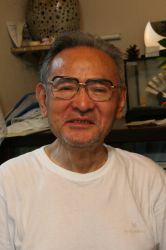The crisis at the Fukushima No. 1 Nuclear Power Plant following the March 11 Great East Japan earthquake and tsunami has caused widespread radiation contamination -- an issue that has cut deeply into the hearts of survivors of the atomic bombs dropped on Hiroshima and Nagasaki. Following are reflections from three atomic bomb survivors -- two of the Hiroshima bombing and one of a close encounter with a U.S. hydrogen bomb -- as Japan marks the 66th anniversary of the August 1945 bombings.
------
Matashichi Oishi

Matashichi Oishi (Mainichi)
Recounting 57-year-old details such as the strange light that emanated from the horizon and the white ash that coated the deck of their boat, 77-year-old Matashichi Oishi, a former deckhand on the tuna fishing boat Fukuryu Maru No. 5 explains: "(It's been etched into my memory) because I've told the story so many times."
On March 1, 1954, the fishing boat Oishi was on was exposed to nuclear fallout from a hydrogen bomb test conducted by the United States on the Bikini Atoll. Six months later, Aikichi Kuboyama, the boat's radio operator who was in the same hospital room as Oishi, died. Other crew members also died in subsequent years from cancer and other illnesses. Both the U.S. and Japanese governments tried to paper over the incident with "sympathy" payments that did not admit their legal responsibility.
Oishi himself has developed cancer and currently takes 32 different drugs. Still, he continues to give lectures and speak to students who visit Hiroshima on school trips, and says he has a responsibility to keep going. He visited Fukushima Prefecture in July, where he spoke about the dangers of radiation.
"I lost my comrades in an unbearable way. I have a responsibility as someone who was also there."
-----

Isao Harimoto (Mainichi)
Isao Harimoto
Isao Harimoto, 71, was speaking to some 370 elementary and junior high school students at a baseball clinic in May in Taiwa, Miyagi Prefecture -- a town that suffered extensive damage from the Great East Japan Earthquake and tsunami -- when his eyes unexpectedly met those of a small boy standing in the front row. The former professional baseball player choked up.
"When I thought about how much that boy must have suffered, just like I did, I was at a loss for words."
When the atomic bomb was dropped on Hiroshima in 1945, 5-year-old Harimoto had been at home, just two kilometers from the hypocenter. Looking at the boy in front of him now, he was reminded of the young boy he was then, just starting to play baseball.
Harimoto told the boy, "Stay strong." He wonders if the boy is still swinging his bat, and hopes that he is.
"Hopefully baseball, which saved me in postwar Japan, will also help those kids through their hardships."
--

Shuntaro Hida (Mainichi)
Shuntaro Hida
Now 94 years old, Shuntaro Hida was based in Hiroshima as a doctor for the Imperial Japanese Army when the atomic bomb was dropped. He began treating victims immediately after the bombing, and continued to do so for over 60 years.
Since the crisis at the Fukushima No. 1 Nuclear Power Plant began, Hida has received an increasing number of requests for both lectures and media interviews. In July, he traveled about twice a week not only within the Tokyo metropolitan area, but as far as Sendai, giving lectures about internal radiation exposure based on his years treating patients for it.
During the U.S.-led occupation of Japan, the U.S. government suppressed information regarding the atomic bomb by controlling the media. Countless people suffering from lethargy and other symptoms as a result of radiation exposure were unable to work and died in poverty. Hida's postwar life has been dedicated to passing down the truth about how the atomic bomb has killed people.
Debate over nuclear power has become heated since the Fukushima crisis began. "Nuclear power is impossible for humans to control," says Hida. "There's no other choice but to eliminate it."
(Mainichi Japan) August 6, 2011








No comments:
Post a Comment